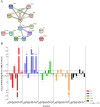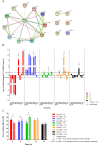N-dodecanoyl-homoserine lactone influences the levels of thiol and proteins related to oxidation-reduction process in Salmonella
- PMID: 30304064
- PMCID: PMC6179229
- DOI: 10.1371/journal.pone.0204673
N-dodecanoyl-homoserine lactone influences the levels of thiol and proteins related to oxidation-reduction process in Salmonella
Abstract
Quorum sensing is a cell-cell communication mechanism mediated by chemical signals that leads to differential gene expression in response to high population density. Salmonella is unable to synthesize the autoinducer-1 (AI-1), N-acyl homoserine lactone (AHL), but is able to recognize AHLs produced by other microorganisms through SdiA protein. This study aimed to evaluate the fatty acid and protein profiles of Salmonella enterica serovar Enteritidis PT4 578 throughout time of cultivation in the presence of AHL. The presence of N-dodecanoyl-homoserine lactone (C12-HSL) altered the fatty acid and protein profiles of Salmonella cultivated during 4, 6, 7, 12 and 36 h in anaerobic condition. The profiles of Salmonella Enteritidis at logarithmic phase of growth (4 h of cultivation), in the presence of C12-HSL, were similar to those of cells at late stationary phase (36 h). In addition, there was less variation in both protein and fatty acid profiles along growth, suggesting that this quorum sensing signal anticipated a stationary phase response. The presence of C12-HSL increased the abundance of thiol related proteins such as Tpx, Q7CR42, Q8ZP25, YfgD, AhpC, NfsB, YdhD and TrxA, as well as the levels of free cellular thiol after 6 h of cultivation, suggesting that these cells have greater potential to resist oxidative stress. Additionally, the LuxS protein which synthesizes the AI-2 signaling molecule was differentially abundant in the presence of C12-HSL. The NfsB protein had its abundance increased in the presence of C12-HSL at all evaluated times, which is a suggestion that the cells may be susceptible to the action of nitrofurans or that AHLs present some toxicity. Overall, the presence of C12-HSL altered important pathways related to oxidative stress and stationary phase response in Salmonella.
Conflict of interest statement
The authors have declared that no competing interests exist.
Figures






Similar articles
-
Acyl homoserine lactone changes the abundance of proteins and the levels of organic acids associated with stationary phase in Salmonella Enteritidis.Microb Pathog. 2017 Jan;102:148-159. doi: 10.1016/j.micpath.2016.11.027. Epub 2016 Dec 1. Microb Pathog. 2017. PMID: 27916690
-
Acyl homoserine lactone-based quorum sensing stimulates biofilm formation by Salmonella Enteritidis in anaerobic conditions.Arch Microbiol. 2017 Apr;199(3):475-486. doi: 10.1007/s00203-016-1313-6. Epub 2016 Nov 12. Arch Microbiol. 2017. PMID: 27838734
-
Furanone and phytol influence metabolic phenotypes regulated by acyl-homoserine lactone in Salmonella.Braz J Microbiol. 2022 Dec;53(4):2133-2144. doi: 10.1007/s42770-022-00809-y. Epub 2022 Aug 10. Braz J Microbiol. 2022. PMID: 35947344 Free PMC article.
-
Molecules Autoinducer 2 and cjA and Their Impact on Gene Expression in Campylobacter jejuni.J Mol Microbiol Biotechnol. 2018;28(5):207-215. doi: 10.1159/000495411. Epub 2019 Jan 29. J Mol Microbiol Biotechnol. 2018. PMID: 30695777 Review.
-
Molecular radio jamming: autoinducer analogs.Chem Biol. 2003 Jan;10(1):1-2. doi: 10.1016/s1074-5521(03)00005-x. Chem Biol. 2003. PMID: 12573691 Review.
Cited by
-
A Bacterial Quorum Sensing Molecule Elicits a General Stress Response in Saccharomyces cerevisiae.Front Microbiol. 2021 Sep 16;12:632658. doi: 10.3389/fmicb.2021.632658. eCollection 2021. Front Microbiol. 2021. PMID: 34603220 Free PMC article.
-
Genome sequencing and analysis of Salmonella enterica subsp. enterica serotype Enteritidis PT4 578: insights into pathogenicity and virulence.Access Microbiol. 2024 Nov 4;6(11):000828.v3. doi: 10.1099/acmi.0.000828.v3. eCollection 2024. Access Microbiol. 2024. PMID: 39686970 Free PMC article.
-
Inhibition of Staphylococcus aureus and Pseudomonas aeruginosa biofilms by quatsomes in low concentrations.Exp Biol Med (Maywood). 2020 Jan;245(1):34-41. doi: 10.1177/1535370219896779. Epub 2020 Jan 5. Exp Biol Med (Maywood). 2020. PMID: 31903777 Free PMC article.
-
N-acyl-homoserine lactone produced by Rahnella inusitata isolated from the gut of Galleria mellonella influences Salmonella phenotypes.Braz J Microbiol. 2022 Jun;53(2):819-829. doi: 10.1007/s42770-022-00681-w. Epub 2022 Jan 20. Braz J Microbiol. 2022. PMID: 35048318 Free PMC article.
-
Quinolone Signals Related to Pseudomonas Quinolone Signal-Quorum Sensing Inhibits the Predatory Activity of Bdellovibrio bacteriovorus.Front Microbiol. 2021 Sep 10;12:722579. doi: 10.3389/fmicb.2021.722579. eCollection 2021. Front Microbiol. 2021. PMID: 34566925 Free PMC article.
References
-
- Quecán BXV, Rivera MLC, Pinto UM. Bioactive phytochemicals targeting microbial activities mediated by quorum sensing In: Kalia V, editor. Biotechnological applications of quorum sensing inhibitors. Singapore: Springer; 2018. pp.397–416.
Publication types
MeSH terms
Substances
LinkOut - more resources
Full Text Sources
Molecular Biology Databases

